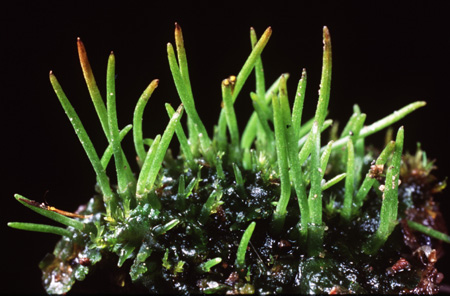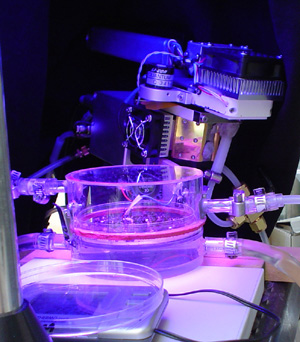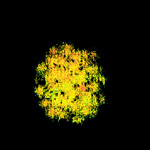
 |
|||||||||||||||
BryoWHAT's?
Bryophytes (mosses, liverworts, and hornworts) are the closest extant relatives to green algae. This basal position among land plants makes them an ideal group of organisms to study when examining the evolution of plants. Since they were the first plants to radiate onto land, comparing their physiological, structural, and developmental traits with those of green algae and other land plants helps elucidate the changes required for green organisms to transition from an aquatic environment to a terrestrial one. In my research on bryophytes, I try to find topics that either demonstrate some of the physiological adaptations needed for life on land, or other topics where bryophytes can provide unique insight into plant or algal physiology and/or ecology. I have listed some examples below that demonstrate the range of bryophyte research I support in my lab.
 Hornworts
are unique among land plants in that they have a structure in their chloroplasts
called a pyrenoid. This is an aggregation of the photosynthetic enzyme Rubisco
(and some other enzymes) that is traversed by thylakoid
Hornworts
are unique among land plants in that they have a structure in their chloroplasts
called a pyrenoid. This is an aggregation of the photosynthetic enzyme Rubisco
(and some other enzymes) that is traversed by thylakoid  membranes.
Pyrenoids are common in a diverse range of algae where they have been shown
to be an integral part of a CCM that directly pumps CO2 or HCO3 to the pyrenoid,
thereby elevating the CO2 concentration around Rubisco and eliminating photorespiration.
This same process has been partially demonstrated by myself and others in pyrenoid
containing hornworts. I am currently studying how structural variation in hornwort
pyrenoids affects CCM function (see my ccm page or my
isotopic studies of photosynthesis page for related information).
membranes.
Pyrenoids are common in a diverse range of algae where they have been shown
to be an integral part of a CCM that directly pumps CO2 or HCO3 to the pyrenoid,
thereby elevating the CO2 concentration around Rubisco and eliminating photorespiration.
This same process has been partially demonstrated by myself and others in pyrenoid
containing hornworts. I am currently studying how structural variation in hornwort
pyrenoids affects CCM function (see my ccm page or my
isotopic studies of photosynthesis page for related information).
 The
small size and poor water retention of most bryophytes creates several problems
for studying their photosynthetic function. Small size means small signal when
studying individual plants or leaves, and a combination of rapid drying and
small size create a large spatial heterogeneity when examining populations of
bryophytes. Fluorescence measurements of photosynthesis are not as limited by
size as gas exchange measurements (though we are also developing a gas exchange
system for small tissue samples - see my MIMS applications on my
isotopic studies of photosynthesis page). We can also use fluorescence to
see variability in photosynthesis that cannot be determined from gas exchange
alone. I am currently collaborating with Dr. Steven Rice at Union College on
canopy structure and photosynthetic function in Sphagnum moss (see my fluorescence
studies of photosynthesis page for more info).
The
small size and poor water retention of most bryophytes creates several problems
for studying their photosynthetic function. Small size means small signal when
studying individual plants or leaves, and a combination of rapid drying and
small size create a large spatial heterogeneity when examining populations of
bryophytes. Fluorescence measurements of photosynthesis are not as limited by
size as gas exchange measurements (though we are also developing a gas exchange
system for small tissue samples - see my MIMS applications on my
isotopic studies of photosynthesis page). We can also use fluorescence to
see variability in photosynthesis that cannot be determined from gas exchange
alone. I am currently collaborating with Dr. Steven Rice at Union College on
canopy structure and photosynthetic function in Sphagnum moss (see my fluorescence
studies of photosynthesis page for more info).
The moss Physcomitrella patens (and possibly mosses in general) are unique among plants because they can be efficiently modified genetically using a process called homologous recombination. This method allows the direct elimination or modification of a gene in its natural location. It is a very powerful tool because of the complex manipulations that can be designed and the robustness of the transformants (other processes have more problems with contaminating signal). I have begun working in this field to manipulate photosynthetic genes and test the effects on function, but my work is still in its infancy.
I have had a long-term interest in bryophyte diversity and distribution starting with the training I received from Dr. Diana Horton at the University of Iowa and enhanced by additional training from Dr. Howard Crum at the University of Michigan Biological Station. I am currently the Associate Curator of the Herbarium in the Museum of Southwestern Biology at the University of New Mexico and my role is to promote the growth and maintenance of the bryophyte collection. I have done a little collecting and identification of mosses in the region, and in future years I hope to work more on the bryophytes of Northern New Mexico and the Sevilleta Long Term Ecological Research Station near Albuquerque.
Isoprene is a 5 carbon hydrocarbon emitted from many plants. Data I collected during my Ph.D. supported the role of isoprene in thermal protection of photosynthesis and examined the regulation of isoprene emission by light and temperature in the environment (see both Hanson and Sharkey 2001 papers). I also developed the hypothesis that light dependent isoprene emission evolved in the mosses and that it would have helped plants cope with new environments as they radiated across the terrestrial environment (see Hanson et al 1999). I am not actively researching isoprene emission at UNM, but I might start some projects in the next few years.